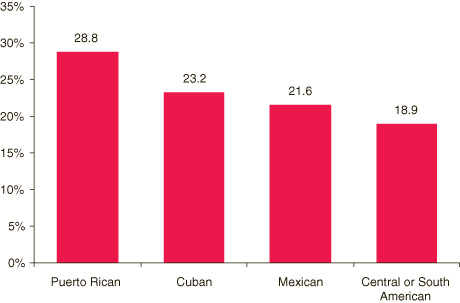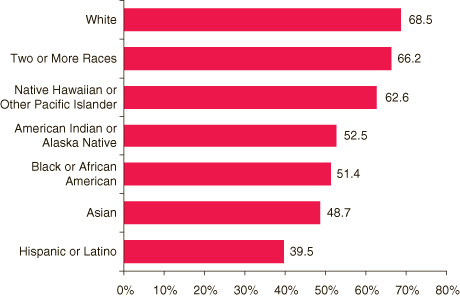
 | |
| Issue 30 | 2006 |
|
In 2002-2004, 25.4 percent of persons aged 12 or older (60.5 million persons) smoked cigarettes in the month prior to the survey. Rates of smoking in the past month were highest among American Indians or Alaska Natives (34.8 percent) and persons of two or more races (34.6 percent), followed by Native Hawaiians or Other Pacific Islanders (28.7 percent), whites (26.6 percent), blacks (24.9 percent), Hispanics (21.9 percent), and Asians (13.4 percent). Among Hispanics, Puerto Ricans were more likely to have smoked in the past month than respondents who identified themselves as Mexican and Central or South American (Figure 1). Among Asians, Korean respondents reported the highest rate of past month smoking and Chinese respondents the lowest (Figure 2).
 |
| Race/Ethnicity | Past Month Cigarette Use |
|---|---|
| Puerto Rican | 28.8 |
| Cuban | 23.2 |
| Mexican | 21.6 |
| Central or South American | 18.9 |
| Source: SAMHSA, 2002, 2003, and 2004 NSDUHs. |
 |
| Race/Ethnicity | Past Month Cigarette Use |
|---|---|
| Korean | 24.9 |
| Vietnamese | 16.4 |
| Filipino | 14.5 |
| Japanese | 13.7 |
| Asian Indian | 12.4 |
| Chinese | 7.5 |
| Source: SAMHSA, 2002, 2003, and 2004 NSDUHs. |
Past month smokers smoked an average of 13.2 cigarettes per day on the days that they smoked. Among smokers, persons of two or more races smoked the highest average number of cigarettes per day on the days that they smoked (15.3 cigarettes), followed by whites (14.9 cigarettes), American Indians or Alaska Natives (10.2 cigarettes), Native Hawaiians or Other Pacific Islanders (9.4 cigarettes), blacks (9.3 cigarettes), Asians (7.6 cigarettes), and Hispanics (6.7 cigarettes).
Past month smokers smoked cigarettes on an average of 23 days during the month before the survey. Whites and persons of two or more races smoked cigarettes on an average of 24.1 and 23.6 days, respectively, in the past month compared with Native Hawaiians or Other Pacific Islanders (22.4 days), blacks (21.3 days), American Indians or Alaska Natives (20.6 days), Asians (20.6 days), and Hispanics (17.3 days). Among Hispanic smokers, Puerto Ricans and Cubans reported smoking on an average of 21 days in the past month compared with Central or South Americans who smoked on 17.2 days or Mexicans who smoked on 15.9 days in the past month.
In 2002-2004, 16.0 percent of persons aged 12 or older smoked daily (i.e., smoked a cigarette on each of the past 30 days), and among current smokers, 62.9 percent (or 38 million) smoked daily. Among past month smokers, whites were more likely to be daily smokers than American Indians or Alaska Natives, blacks, and Asians (Figure 3). As a group, Hispanic smokers were less likely to be daily smokers than smokers of all other racial/ethnic groups; however, there were some differences within the Hispanic group. Puerto Rican and Cuban smokers (56.3 and 56.2 percent, respectively) were more likely to report daily cigarette smoking than Central or South American and Mexican smokers (37.8 and 34.0 percent, respectively).
Among past month smokers, daily smokers smoked an average of 17.5 cigarettes per day in the past month. Among daily smokers, persons of two or more races and whites smoked the highest average number of cigarettes per day (18.9 and 18.8 cigarettes, respectively). Among Asian daily smokers, Japanese respondents reported smoking the highest average number of cigarettes per day. Among Hispanic daily smokers, Cubans reported smoking the highest average number of cigarettes per day.
 |
| Race/Ethnicity | Past Month Daily Smokers |
|---|---|
| White | 68.5 |
| Two or More Races | 66.2 |
| Native Hawaiian or Other Pacific Islander | 62.6 |
| American Indian or Alaska Native | 52.5 |
| Black or African American | 51.4 |
| Asian | 48.7 |
| Hispanic or Latino | 39.5 |
| Source: SAMHSA, 2002, 2003, and 2004 NSDUHs. |
| The National Survey on Drug Use and Health (NSDUH) is an annual survey sponsored by the Substance Abuse and Mental Health Services Administration (SAMHSA). Prior to 2002, this survey was called the National Household Survey on Drug Abuse (NHSDA). The combined 2002, 2003, and 2004 data are based on information obtained from 203,670 persons aged 12 or older. The survey collects data by administering questionnaires to a representative sample of the population through face-to-face interviews at their place of residence. The NSDUH Report is prepared by the Office of Applied Studies (OAS), SAMHSA, and by RTI International in Research Triangle Park, North Carolina. (RTI International is a trade name of Research Triangle Institute.) Information on NSDUH used in compiling data for this issue is available in the following publications: Office of Applied Studies. (2005). Results from the 2004 National Survey on Drug Use and Health: National findings (DHHS Publication No. SMA 05-4062, NSDUH Series H-28). Rockville, MD: Substance Abuse and Mental Health Services Administration. Office of Applied Studies. (2004). Results from the 2003 National Survey on Drug Use and Health: National findings (DHHS Publication No. SMA 04-3964, NSDUH Series H-25). Rockville, MD: Substance Abuse and Mental Health Services Administration. Office of Applied Studies. (2003). Results from the 2002 National Survey on Drug Use and Health: National findings (DHHS Publication No. SMA 03-3836, NSDUH Series H-22). Rockville, MD: Substance Abuse and Mental Health Services Administration. Also available online: http://www.oas.samhsa.gov. Because of improvements and modifications to the 2002 NSDUH, estimates from the 2002, 2003, and 2004 surveys should not be compared with estimates from the 2001 or earlier versions of the survey to examine changes over time. |
| The NSDUH Report (formerly The NHSDA Report) is published periodically by the Office of Applied Studies, Substance Abuse and Mental Health Services Administration (SAMHSA). All material appearing in this report is in the public domain and may be reproduced or copied without permission from SAMHSA. Additional copies of this report or other reports from the Office of Applied Studies are available online: http://www.oas.samhsa.gov. Citation of the source is appreciated. For questions about this report, please e-mail: shortreports@samhsa.hhs.gov. |
|
This page was last updated on December 30, 2008. |